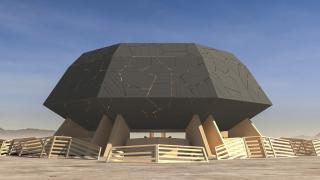It seems that the curators of the Lisbon Architecture Triennial, Ann-Sofi Rönnskog and John Palmesino, have the city in mind. At least, that can be deduced from the program of this seventh edition which, under the title How heavy is a cityhe asks how far the tentacles of the urban reach in this era we call Anthropocene.
Despite the neologisms, the question is more pertinent than novel, since a century ago, for example, the biologist Patrick Geddes understood that the city, more than a set of buildings, is an incomprehensible totality of new and old techniques, natural resources and energy sources.
The equation, therefore, is tricky, because it contains too many factors to yield accurate conclusions. But we are in times of algorithms and data rain clouds; Maybe it’s time to insist and do it in Lisbon.
If activities such as the symposium are left aside Talk, Talk, Talkat the Calouste Gulbenkian Foundation, The Triennial is basically organized in three venues and three exhibitions.
Thus, the Design Museum (MUDE), located in Baixa, houses Spectresthe old Tajo del MAAT power plant houses Fluxes and finally, Lighter It is displayed in the Garagem Sul of the Belém Cultural Center, where some of the independent projects that are spread throughout the city are also presented, even in the Estufa Fría.
Fiat Lux Experience for the Lisbon Architecture Triennale, in ‘Spectres’. Photo: Fiat Lux Experience
In a very general way, the first talks about technology and the visual representations of our world, the second measures the material problem of the city and the third proposes new paradigms.
As is increasingly common in these events, the Triennial is configured to suit the extradisciplinary interests of the Academy, research rather than orthodox praxis.
This means that their budgets are smaller and the guests point more to the future than in other similar events, such as those in Venice or Chicago: in 2013, for example, Frida Escobedo and Andrés Jaque participated, today in charge of the reform of the Pompidou and the Columbia school of architecture, respectively. Rönnskog and Palmesino break that profile a bit: they are not exactly young anymore –she is from 1976, he from 1970–, and that It is noticeable in its excessive imprint on the result.
And, as any regular at these soirées knows – from the Portuguese, saran–, people take statements very much in their own way. Perhaps for this reason, the commissioners have been somewhat Germanically determined to impose are format.
At each stop, all contributions are presented exactly the same: like an audiovisual on a monitor. To be fair, there is always something that goes outside the box – such as Patti Smith’s gigantic projection with verb, in Baixa, or Iwan Baan’s photographic project on oil extraction in Alberta, next to the Tagus – but it is clear that This Triennial we have come to see it on TV.
Grok, how much CO2 does a Madrid-Lisbon plane emit? “72 kg per passenger per trip.” The weight of the contest will thus be proportional to its success, a paradox that is not justified if what we face on site es a series of videos that we could watch peacefully from home.
‘Roadside Picnic’, by Hugo David for the Lisbon Architecture Triennale. Photo: Hugo David
Beyond this eco-anxiety, The viewer’s experience can also be improved.. The monotony of display In the fifty pieces – some lasting more than half an hour – he tamps down even the most interesting contributions.
Among those of the Spanish architects, those of Marina Otero stand out (along with Daniel Miller) in Spectreswith a project on the creation of a digital twin of Tuvalu – an island country about to sink into the Pacific due to climate change –, and that of the Barcelona study 300,000 km (Pablo Martínez and Mar Santamaría) in Fluxesand that details, precisely, the terrifying increases in carbon emissions.
You can also see works of Blanca Pujals in the MUDE, Pablo Pérez-Ramos and the artist Abelardo Gil-Fournier at Garagem Sul and again Otero at MAAT.
Among the international contributions, there are even a true story about a Portuguese pioneer of solar energyby Matilde Seabra, and another fiction one, by Geoff Manaugh, about a scientist who spies with cosmic particles. We can’t say what it has to do with the topic, but we like it.
Among so much breadth of vision, attractive although suspicious of dilettantism, a doubt floats in the air, like those molecules that are measured in these installation films. ¿What possibilities does all this magma have to connect with the public?to last?
The approach, so atomized and abstractmakes one fear that the story will be lost in confusing anecdotes, single images and some flashes of memory that will go out with the last glow of the monitors. And while it is true that evangelizing is hard, pedagogy – even academic speculation – consists in making the Gospel not seem that way.
Carlo Cattaneo, 19th century: “The majority of that land, then, is not the work of nature, but of our hands; It is an artificial homeland“He was never modern nor was he invited to Lisbon, but he summarizes better than anyone – and with lightness – what this Triennial, which will remain open until January 2026, has to say.

